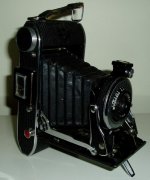I've got a PB20 and I restored it, along with a PD16, so I know about this one.
First, remove the shutter from the camera. There is a ring at the back of the shutter that holds it to the front standard. Unscrew this. Next, remove the lenses. The front element just unscrews (after you remove the studs that stop it from turning), but you will need a lens wrench to remove the center and rear elements. You will have to remove them from the front and from the back. There are two screws on the face plate of the shutter (either side of the lens). You will have to remove these and after that it becomes pretty self-evident what will need to be done. If you have not done this before, then after removing the shutter speed cam plate (the big slotted disk on the front), you had better stop there. This will give you access to the guts of the shutter and you will not be getting in over your head.
Flush the shutter's guts out with lighter fluid and use an artist's watercolor brush to get in between the parts and scrub the old lube out. Flush it again. Repeat 3 times. Then you use more lighter fluid on cotton swabs to clean the shutter blades and aperture blades, front and back. On the escapements only (speeds and self timer, if you have one -- I don't remember), use the artist's brush, slightly dampened with one drop of very light oil (Remoil or watch oil) per teaspoon of lighter fluid, and work the bristles between the gears to lightly lube it. The brush should be just slightly damp. Do not get any oil on the shutter blades. Oil on the shutter blades will cause them to stick together and they won't work. Better no oil at all than too much, so don't be tempted to use more oil.
As you clean the shutter blades with the wet naptha (lighter fluid) work the shutter blades a few times, then mop up the lighter fluid with the dry end of the swab. Do this about 50 times (no, I'm not joking, 50 times, on each side). After you've done all this, let it dry out overnight and test it to see if it still sticks. If it does, you will have to do it all over again. Just keep at it until your shutter stops sticking. There are better ways to do this, but it works (if you are persistent) and it is safe for beginners -- in that you won'te get in over your head and wind up with a bunch of parts that you can't figure out how to get back together again.
Note: before tripping the shutter (which you will have to do several times when cleaning the shutter blades), put the shutter speed cam and face plate back on. That will keep any loose springs and parts from flying out -- like they probably will if you do this with the front of the shutter open.


